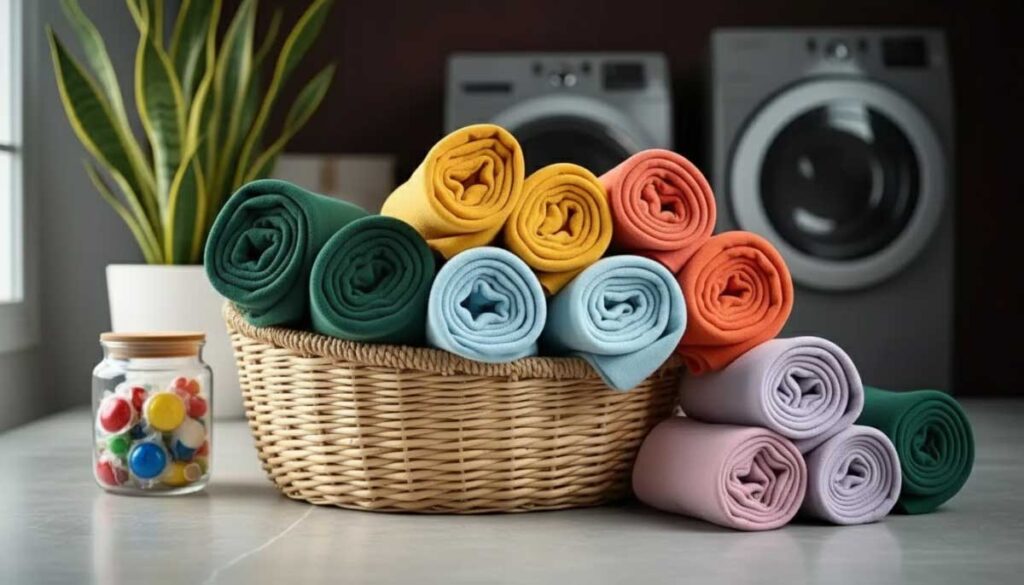Care Symbols Decoder
Upload care label text or select symbols to get clear, step-by-step care instructions
Click the symbols you see on your care label
Type or paste the text from your care label
Select Care Symbols:
🧺 Your Care Routine
💰 Cost Comparison
🆘 Emergency Care Tips
💡 Pro Tips
Care labels should not feel like a puzzle. I built a lightweight Care Symbols Decoder that turns laundry symbols and fussy label text into plain steps you can follow. Use the printable Laundry Symbols Chart below, or tap the decoder for a one minute plan you can copy or print.
How to Read Laundry Symbols, One Minute Guide
Translation in under a minute. Pick the symbol names that match your tag or paste the label text. You get a short plan for wash, dry, iron, bleach, and dry clean. Print it, or copy the steps to your notes. I keep it open next to the washer, it saves me from guesswork.
Washing Machine Symbols Explained
Washing symbols control water temperature and agitation. Dots signal heat, underlines signal gentler cycles. Use the chart for quick checks, then let the decoder turn those marks into a plain routine you can follow without thinking.
Printable Laundry Symbols Chart, Quick Reference
Here is the chart. Quick print tip, use your browser’s print button for a one page handout, it fits letter and A4.
Legend
One underline means permanent press. Two underlines mean delicate. One bar under a circle means gentle professional cycle.
| Symbol text | Meaning | Plain instruction | Common mistake |
|---|---|---|---|
| Cold wash, 30°C, 86°F | Cold wash | Cold cycle with regular detergent, keeps dyes from wandering | Switching to warm by habit |
| Warm wash, 40°C, 105°F | Warm wash | Warm cycle for everyday loads, balanced clean and care | Using hot and shrinking fabric |
| Hot wash, 60°C, 140°F | Hot wash | Hot cycle for whites and sturdier items only | Washing wool or silk on hot |
| Hand wash | Hand wash only | Soak, swish gently, rinse cool, press water out with a towel | Scrubbing or wringing |
| Permanent press, one underline | Reduced agitation | Lower agitation and slower spin, fewer creases to iron later | Choosing heavy duty cycle |
| Delicate, two underlines | Gentle cycle | Gentle cycle, mesh bag helps keep shape and trims snag risk | Spinning at full speed |
| Do not wash | No wash | Professional care or spot clean only | Trying a quick machine cycle |
| Bleach allowed | Any bleach ok | Use bleach only when needed, test first on a seam | Overusing on colors |
| Oxygen bleach only | Non chlorine only | Oxygen based bleach only, protects most dyes | Grabbing chlorine bleach |
| Do not bleach | No bleach | Skip all bleach types, stick to detergent and pretreat | Using oxygen bleach anyway |
| Line dry | Natural dry, hanging | Hang on a rack or line with airflow, smooth seams by hand | Drying in harsh sun for hours |
| Drip dry | Natural dry, dripping | Hang and let water drip off, no reshaping until dry | Stretching or smoothing while wet |
| Line dry in shade | Natural dry, shaded | Hang out of direct sun to avoid fade and heat shrink | Sun fade and heat shrink |
| Dry flat | Lay flat to dry | Lay on a rack or towel, reshape while damp, stops knits from growing | Hanging knits so they stretch |
| Do not wring | No twisting | Press water out with a towel, be gentle with seams | Twisting sweaters and knits |
| Tumble allowed, no dot shown | Tumble allowed | You can tumble, check other marks on your tag for heat dots | Assuming any heat is fine |
| Tumble dry low, one dot | Low heat tumble | Low heat, pull while slightly damp, finish on a rack | Cranking heat to finish faster |
| Tumble dry medium, two dots | Medium heat tumble | Medium heat, remove promptly to avoid stiffness | Overdrying until stiff |
| Tumble dry high, three dots | High heat tumble | High heat for sturdy fabrics only, watch prints | Using on synthetics and elastane |
| Do not tumble dry | No dryer | Air dry or flat dry only, skip the lint trap drama | Tossing in the dryer to “fluff” |
| Iron low, one dot | Cool iron | Lowest setting, add a press cloth on delicate areas | Touching prints with a hot soleplate |
| Iron medium, two dots | Medium iron | Medium heat with steam, keep the iron moving | Parking the iron in one spot |
| Iron high, three dots | Hot iron | High heat for cotton and linen, steam helps crisp seams | Scorching delicate weaves |
| Do not iron | No iron | Skip heat and pressure, try distance steaming | Testing heat on a tiny corner |
| No steam | Iron without steam | Iron dry only, press cloth helps control shine | Blasting steam on silk or wool |
| Dry clean | Professional clean | Take to a cleaner, ask about solvent choice and stains | Treating it as optional |
| Dry clean P | P solvents | Perchloroethylene class solvents, flag stains at check in | Washing at home anyway |
| Dry clean F | Hydrocarbon solvents | Choose a cleaner that offers F solvents for delicate trims | Assuming all cleaners are the same |
| Dry clean A | Any solvent | Broadest pro option, still professional only | Thinking A means safe at home |
| Gentle professional cycle, one bar | Gentle dry clean or wet clean | Request gentle cycle at the cleaner, less agitation | Ignoring the bar modifier |
| Professional wet clean W | Pro wet clean | Water based pro process, not a DIY soak | Trying to copy it in a sink |
| Professional wet clean W, bar modifiers | Gentle or very gentle wet clean | Reduced agitation per bars, safer for structure | Attempting on a regular washer |
If you are not sure, choose colder water, a gentler cycle, and air dry. These follow ISO and GINETEX conventions. If your region uses different marks, match the wording on your tag.

Washing Symbols Explained
- Washing symbols, cold, warm, hot, hand wash, do not wash, and delicate modifiers.
Drying Symbols Explained
- Drying symbols, tumble low, medium, high, do not tumble, line dry, drip dry, line dry in shade, flat dry, do not wring.
Ironing Symbols Explained
- Ironing symbols, low, medium, high, no iron, no steam.
Bleach Symbols Explained
- Bleaching symbols, bleach allowed, oxygen bleach only, do not bleach.
Dry Clean Symbols and Professional Wet Clean
- Professional cleaning, dry clean with letters P, F, A, gentle bars, professional wet clean W.
Care Symbols Decoder, How It Works
Open the page, then pick your path, symbols or text.
Choose symbols, and tap what you see on the tag, hand wash, no bleach, flat dry.
Paste text instead, and drop in the wording, machine wash cold, gentle cycle, tumble dry low, do not iron.
Tap Decode. A short routine pops up with do and do not notes, temps in °C and °F, and any warnings. You can scroll, print, or copy the steps into your phone.
Heads up on scope
This version covers the most common marks. If your tag mixes rare or regional symbols, you still get a safe plan, and anything unclear gets flagged.
Your Results Explained, Care Label Symbols and Meanings
Here is how the plan makes choices.
- If a tag says dry clean only, home washing is marked not advised, and you see a typical cleaner cost so you can plan.
- Do not bleach wins over every other bleach note.
- Do not tumble beats any heat dots.
- Conflicts inside pasted text get resolved to the safest option first, and the tool explains what it overrode.
Fabric Care Tips by Material

- Cotton, warm wash works, medium heat dry, watch prints.
- Wool, cool water, no tumble, reshape flat, avoid wringing.
- Silk, cool hand wash or dry clean, low steam, skip bleach.
- Linen, warm wash, medium to high iron with steam, expect light shrink.
- Modal, cool wash, low tumble, feels sturdy but can pill on high heat.
- Acetate, cool hand wash or dry clean, no steam, heat can distort sheen.
- Rayon or viscose, cool wash only, no tumble, lay flat, fabric can grow or shrink.
- Synthetics like polyester or nylon, cool wash, low tumble, high heat can warp.
- Denim, inside out, cold wash, line dry to reduce dye transfer.
- Elastane blends, protect stretch with cool wash and low heat, skip fabric softener on performance wear.
Emergency Care, Fast Fixes
Color bleed, rewash cold with a color catcher, do not dry until the water runs clear.
Shrink surprise, soak in lukewarm water with a little hair conditioner for 30 minutes, ease back to shape, dry flat.
Scorch mark, stop heat, cool the area, try gentle steaming from a distance, do not press directly.
Denim dye transfer, rinse cold alone, vinegar helps odor only, it does not set dye.
Simple Laundry Routine Recipe
Sort by color and fabric. Pretreat stains. Wash on the decoded setting, cold and gentle if the tag is unclear. Dry as instructed, air or flat dry when in doubt. Iron at the stated level, start low and test on an inside seam. Store clean and fully dry.
First Hand Mini Test
I tried a real tag, machine wash cold, gentle, non chlorine bleach only, do not tumble, flat dry, cool iron. The decoder returned a tidy routine, cold wash on delicate, oxygen bleach only, skip the dryer, lay flat, low iron with a press cloth. It flagged flat dry as critical, which kept me from hanging it out of habit.
Compact FAQ
What do laundry symbols mean?
They are a shorthand for washing, drying, ironing, bleaching, and professional cleaning. Match the mark to its family, then follow the specific dot or line cues.
What is tumble dry low?
Use low heat, pull items while slightly damp, finish on a rack to prevent stiffness.
Can I use bleach?
Only if the chart says bleach allowed. Oxygen bleach is safer on colors. Never mix bleach and ammonia.
What does hand wash mean?
Cool water, gentle swish for a few minutes, rinse cool, press water out with a towel, no wringing.
What does P in a circle mean?
Dry clean with P class solvents. Tell the cleaner about stains and trims.
How do I read care labels from text?
Paste the wording into the decoder, it outputs a step by step plan in plain language.
Care Plan Box, Mirrors The Tool
- Wash, follow the decoded temperature, when unclear use cold on gentle.
- Dry, match the symbol text, low heat if tumble is allowed, air or flat dry when in doubt.
- Iron, use the stated level, start low, test on an inside seam, use a press cloth on delicate fabrics.
- Bleach, only if allowed, oxygen bleach is safer on colors, never mix bleach and ammonia.
- Dry clean, required if marked, skip home wash.
Fit and Finish Notes, Standards and Safer Defaults
Labels vary by region. These follow ISO and GINETEX conventions. If anything looks unfamiliar, compare your tag to the chart and the plan the tool gives you. When in doubt, pick colder water, a gentler cycle, and air dry.
Helpful Tools On Blufashion
- Save time with the Event Outfit Generator, clear outfit formulas by dress code.
- Dial in comfort with the Bra Size Calculator, quick sister sizes with fit tips.
- Protect skin while you wash and dry with the SPF Amount Calculator, exact pumps and timing.
- Color match your fabrics and makeup with the Undertone Finder Quiz, fast undertone guidance.
- If lingerie is in the load, check the Lingerie Fit Troubleshooter, practical fixes that make pieces last.
Compliance
Plain words, clear choices. If a tag says dry clean only, treat it as such. Always spot test stain removers on a hidden seam. The tool gives safe defaults when a tag is unclear.





